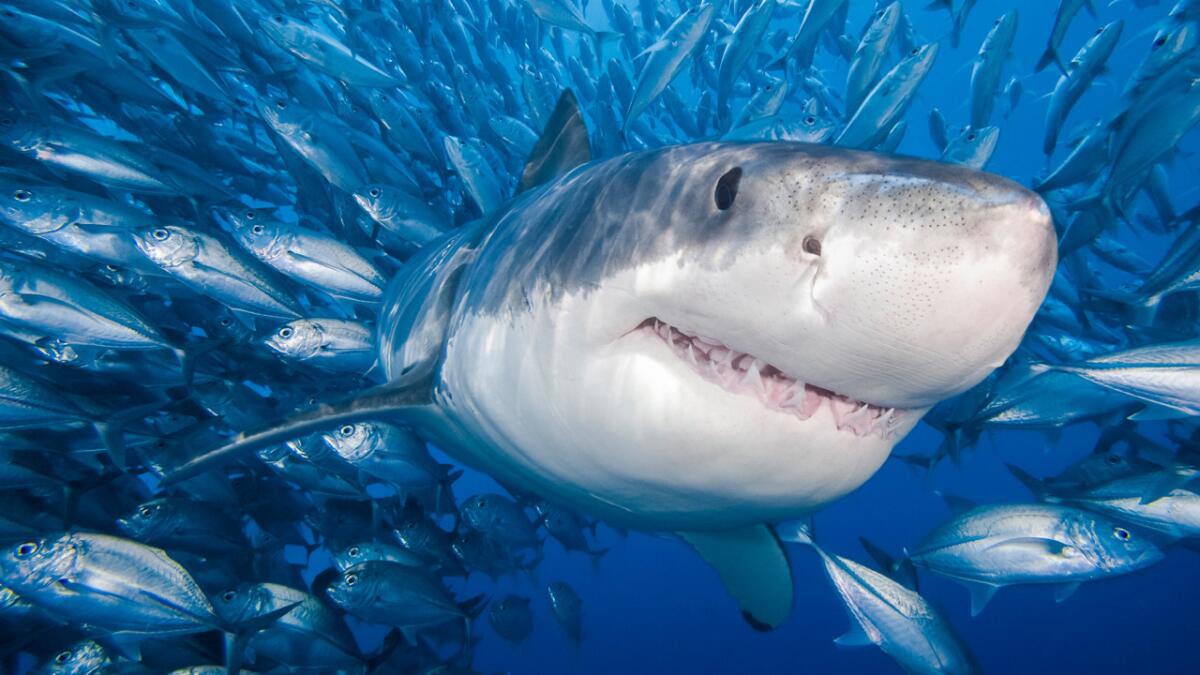Shark attacks on the rise? In California, the risk has plunged

A great white shark is surrounded by a school of bigeye trevally. A new study says that the rate of shark attacks in California is declining, not rising.
- Share via
California may be plagued by earthquakes, brush fires and a record-breaking drought. But here’s one way life has gotten better in the Golden State: The risk of being attacked by a shark has plunged.
Since 1950, the odds of being bitten by a white shark (Carcharodon carcharias) in waters off the California coast have dropped by 91%, according to an analysis by scientists from Stanford University and the Monterey Bay Aquarium. Swimmers, scuba divers and abalone divers all saw massive declines in shark attack risk over the past 63 years.
“California ocean goers are safer today than at any other time since the 1950s,” the researchers wrote in a study to be published by the journal Frontiers in Ecology and the Environment.
In absolute terms, the number of attacks by white sharks has gone up since the Beach Boys released their first single and “Gidget” went on the air. Data from the Global Shark Attack File show there were an average of 0.9 attacks per year in California in the 1950s, rising to an average of 1.5 attacks per year between 2004 and 2013, the final decade in the analysis. There were 86 shark attacks during the study period, including 13 that were fatal.
However, the increase in the number of attacks was swamped by the increase in people in the water. California’s coastal population tripled from 7 million in 1950 to 21 million in 2013. Accordingly, the number of California beachgoers more than tripled from an estimated 53 million in the 1950s to 165 million in 2013, the researchers wrote.
Even more striking, the number of surfers in California increased nearly 125-fold, rising from 7,000 in 1950 to 872,000 in 2013. Additionally, the number of certified scuba divers swelled from about 2,000 in the early 1960s to approximately 408,000 in 2013.
With so many more people in the water, the rate of attacks by white sharks fell by 2.4% per year, the researchers calculated.
By 2013, there were only 0.69 shark attacks for every 1 million abalone diving days and 0.007 attacks per 1 million scuba diving days. Surfers had a 1-in-17 million chance of being bitten by a white shark, while swimmers reported just one attack per 738 million beach visits, according to the study.
To put those risks into perspective, the researchers used data from the Centers for Disease Control and Prevention to calculate that Californians were 1,817 times more likely to drown than be attacked by a white shark.
Although the odds are already low, the analysis did find ways to make them even lower. White sharks appear to be following elephant seals, whose colonies have moved north during the study period. That’s probably one reason why the risk of a shark attack is 1,566 times lower off the coast of San Diego or Los Angeles in March than it is in the waters off Mendocino in October or November, wrote the researchers, who study sharks and marine ecosystems.
No culling campaign has ever been shown to reduce shark attack risk to such a great extent, they added.
For more science news, follow me on Twitter @LATkarenkaplan and “like” Los Angeles Times Science & Health on Facebook.







